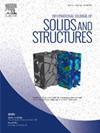An investigation of rapid surface melting in nanowires
IF 3.4
3区 工程技术
Q1 MECHANICS
International Journal of Solids and Structures
Pub Date : 2024-10-23
DOI:10.1016/j.ijsolstr.2024.113106
引用次数: 0
Abstract
The investigation into virtual melting phenomena in nanowires holds significant relevance owing to its profound impact on material durability under extreme loading conditions. Thus, the exploration of this pivotal plastic deformation mechanism is undertaken utilizing the phase-field methodology. Employing a monolithic solver, we solve the coupled highly nonlinear time-dependent Ginzburg–Landau equation and dynamic elasticity equation. Our analysis encompasses the consideration of surface tension stress in conjunction with a coherent solid–liquid interface subjected to uniaxial transformation strain, thereby unveiling intriguing facets of melting phenomena. The investigation delves into the influence of transformation strain, kinetic coefficient, and temperature on the thickness of the solid–liquid interface and its corresponding velocity. This analysis is conducted through meticulous comparison with existing experimental data and molecular dynamics simulation. Moreover, employing the phase-field method yields precise descriptions of the system kinetics, capturing virtual melting phenomena in both pristine and flawed nanowire configurations.
纳米线表面快速熔化的研究
纳米线中的虚拟熔化现象对极端载荷条件下的材料耐久性具有深远影响,因此对其进行研究具有重要意义。因此,我们利用相场方法探索了这一关键的塑性变形机制。我们采用单片求解器,求解了高度非线性时变金兹堡-朗道方程和动态弹性方程。我们的分析考虑了表面张力应力与单轴转换应变下的相干固液界面,从而揭示了熔化现象的有趣方面。研究深入探讨了转化应变、动力学系数和温度对固液界面厚度及其相应速度的影响。这一分析是通过与现有实验数据和分子动力学模拟进行细致比较后得出的。此外,采用相场方法还能精确描述系统动力学,捕捉原始和有缺陷纳米线构型中的虚拟熔化现象。
本文章由计算机程序翻译,如有差异,请以英文原文为准。
求助全文
约1分钟内获得全文
求助全文
来源期刊
CiteScore
6.70
自引率
8.30%
发文量
405
审稿时长
70 days
期刊介绍:
The International Journal of Solids and Structures has as its objective the publication and dissemination of original research in Mechanics of Solids and Structures as a field of Applied Science and Engineering. It fosters thus the exchange of ideas among workers in different parts of the world and also among workers who emphasize different aspects of the foundations and applications of the field.
Standing as it does at the cross-roads of Materials Science, Life Sciences, Mathematics, Physics and Engineering Design, the Mechanics of Solids and Structures is experiencing considerable growth as a result of recent technological advances. The Journal, by providing an international medium of communication, is encouraging this growth and is encompassing all aspects of the field from the more classical problems of structural analysis to mechanics of solids continually interacting with other media and including fracture, flow, wave propagation, heat transfer, thermal effects in solids, optimum design methods, model analysis, structural topology and numerical techniques. Interest extends to both inorganic and organic solids and structures.

 求助内容:
求助内容: 应助结果提醒方式:
应助结果提醒方式:


